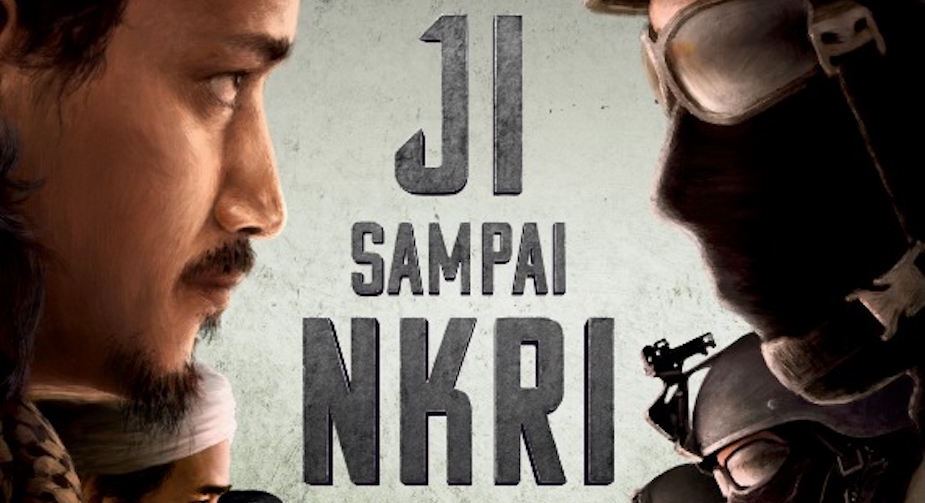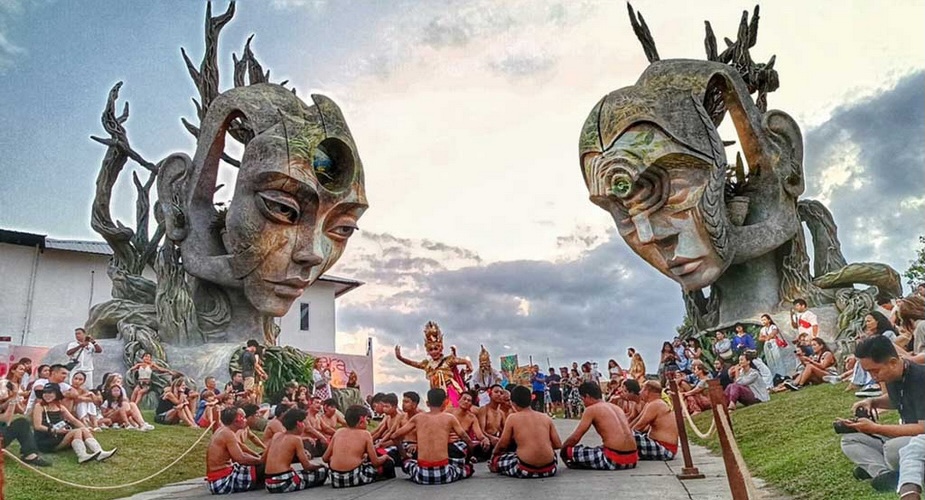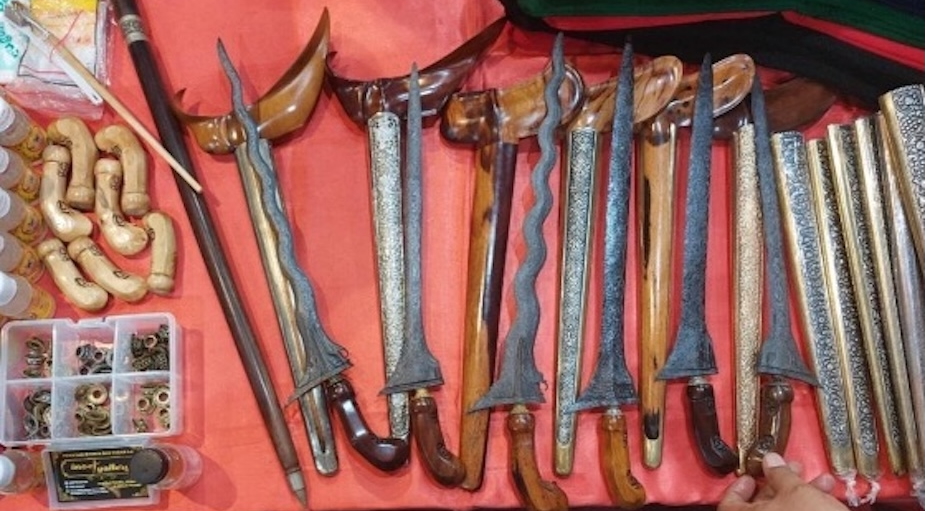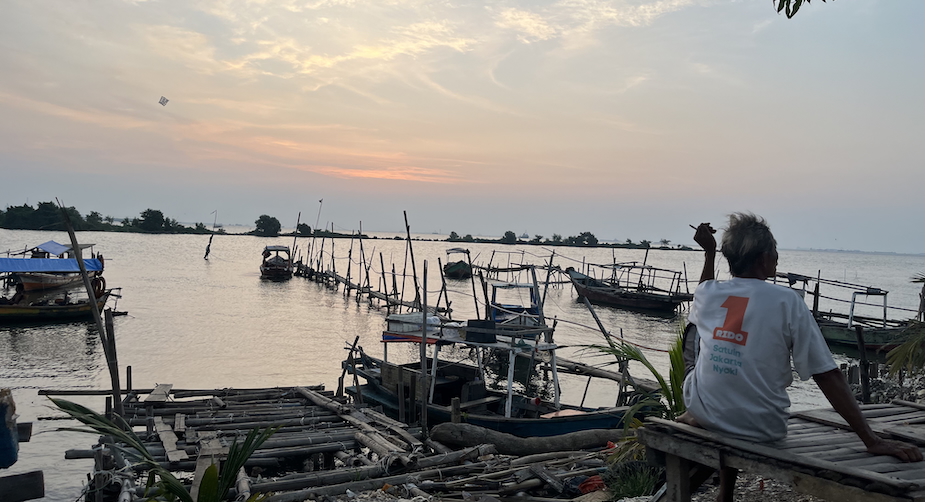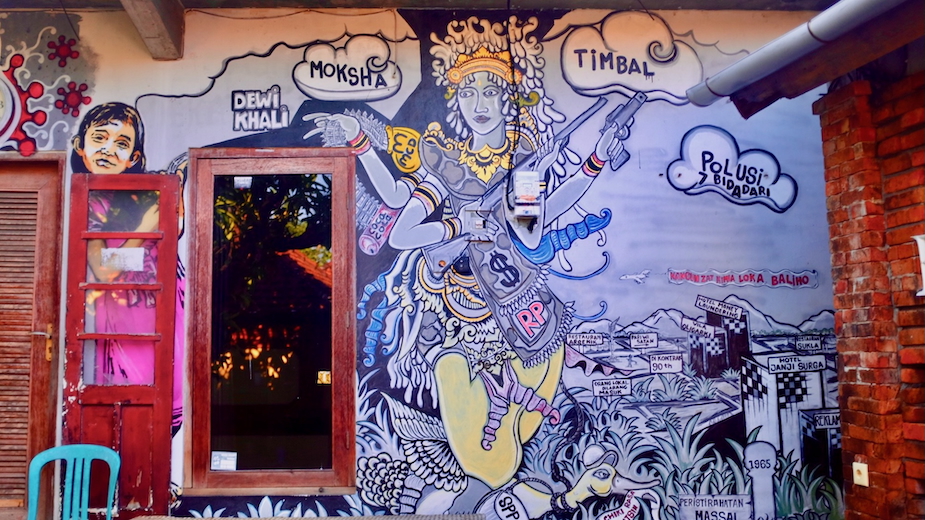An essay introducing Ki Purbo Asmoro’s original wayang tale Tamba Tĕka, Lara Lunga (Remedy Shows Up, Malady Gives Up)
Kathryn ‘Kitsie’ Emerson
When renowned dhalang Purbo Asmoro received Siddharth Chandra's invitation to create and perform a full-length wayang kulit tale based on the 1920 play Awas Lĕlara Inpluwensa (Beware the Disease of Influenza), he was immediately inspired by the challenge. Purbo Asmoro is no stranger to creative construction of wayang tales that fall outside of traditional structures and was already active in addressing the COVID-19 pandemic through his art. Having received the materials from Siddharth Chandra on 5 July 2021, he live-streamed his original work entitled Tamba Tĕka, Lara Lunga (Remedy Shows Up, Malady Gives Up) on his YouTube channel on 28 September 2021, only two-and-a-half months later.
In the four to five years before the outbreak of the COVID-19 pandemic, dhalang across Java had been embracing live-streaming of their performances. By 2018, almost every major dhalang across Java had started a YouTube channel and was broadcasting performances regularly. Superstar dhalang might have as many as 2,000 in attendance at their wayang and as many as another 10,000 viewing the live stream on YouTube. This established medium of wayang in a virtual format was to come in handy once COVID-19 began to ravage Java and other parts of Indonesia in early 2020.
Finding a voice during the pandemic
The first of many COVID-19 lockdowns in Indonesia was put into place on 20 March 2020. This sent a shock wave through the dhalang community whose profession is characterised by gathering large crowds in relatively small spaces. Purbo Asmoro was the first dhalang to make a public statement of concern just five days later, on 25 March 2020. Without warning or fanfare, he began to broadcast live from his home via YouTube and proceeded to perform a wayang completely alone – no 25 member gamelan troupe accompaniment, no technical team, and not a single person in the audience. He performed a ritual-cleansing story known as Sudamala (Lessen the Affliction) and by midnight much of the artistic community in Java was abuzz, emboldened by the idea that COVID-19 shutdowns did not have to mean artistic silence.
Purbo Asmoro continued to directly address the suffering and frustration caused by the pandemic in 62 subsequent performances, mostly virtual, held almost weekly over the next 18 months. Through his original interpretations of wayang tales, which he made relevant to what was happening, he invited the community to reflect on the effects of the pandemic.
The invitation by Siddharth Chandra, however, was something very different. Over 100 years ago, a fellow Javanese dhalang was asked by a Dutch colonial health official to create a play (Purbo Asmoro felt the 1920 play was written by a dhalang, but we cannot know for sure) that would educate the general public on how to treat the sick and prevent further spread of the disease during the 1918 flu pandemic. And now Purbo Asmoro had the script, complete with some simple illustrations, in his hands. This powerful connection to the suffering of his fellow Indonesians from a century ago, through the words of a fellow dhalang, captivated his imagination. Purbo Asmoro went about the process of studying the script as a starting point for constructing a full-length wayang, which he hoped would be dynamic, and meaningful to his current-day audience.
Inspiration despite a personal crisis
Two factors came into the equation that both slowed Purbo Asmoro down and helped forge an even more intimate relationship with the project. First, almost simultaneously upon receiving the proposal from Siddharth Chandra, Purbo Asmoro himself came down with a serious case of the Delta variant of COVID-19. Although he was quite ill, he had decided not to tell anyone outside his immediate household. He felt it was crucial to keep knowledge of his illness out of the general artistic community chatter, because of the second factor in the equation – his elder colleague, friend and a legendary superstar dhalang, Manteb Soedharsono, had died of COVID-19 three days earlier, and Purbo Asmoro had likely fallen ill as a result of the same superspreader.
A powerful government official had skirted the pandemic regulations and sponsored a mass-audience wayang in Jakarta, with Manteb Soedharsono as the dhalang and Nurroso Ensemble, directed by Blacius Subono, as the gamelan troupe. By the time the crew returned from Jakarta many of them had started to feel ill. Purbo Asmoro’s son, Kukuh Indrasmara, was one of the Nurroso performers. The troupe returned to Solo on 26 June 2021 and Manteb Soedharsono passed away a week later, on 2 July 2021. Four days after returning home, Purbo Asmoro’s son Kukuh came down with the infection and soon after that his mother, older brother, and finally, on 3 July, his father, Purbo Asmoro followed suit.
Dhalang are some of the most revered members of any traditional Javanese neighborhood. Superstar dhalang, like Manteb Soedharsono and Purbo Asmoro tend to be idolised by the entire nation. They are thought to be able to do no less than shift the path of a rainstorm away from an important event and are trusted to keep their entire crew safe from traffic accidents, illnesses, or other turns of bad luck. While it might have been understandable that a virus was killing off average citizens, it was incomprehensible to many that it had conquered the life of the invincible Manteb Soedharsono. And now, Purbo Asmoro had isolated himself away in his room, deathly ill from the very same strain of the virus, imagining how overwhelming it might be if the news of his illness came out.
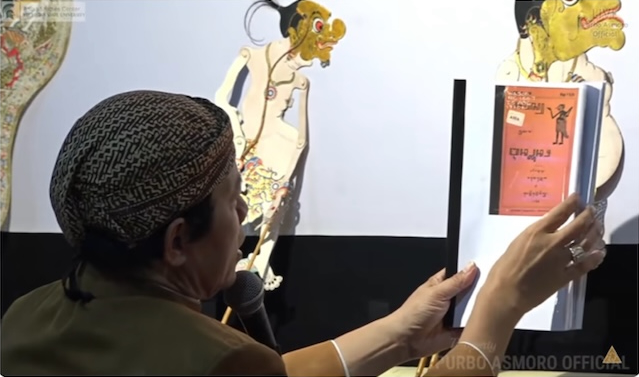
It was in this context that Purbo Asmoro received the invitation from Siddharth Chandra to study the 1920 pamphlet Awas Lĕlara Inpluwensa, two days into his own illness and three days after the death of Manteb Soedharsono. Holed up in his room, well-aware of the serious shortage of both medical care and equipment available in Solo, he tried to ignore his symptoms by immersing himself in the nine characters and five short scenes in the pamphlet. By the end of July he was feeling better, and he had mapped out a wayang kulit story in three acts (known as a lakon) with 18 scenes, 30 characters, and 32 distinct gamelan selections to support the dramatic flow. Purbo Asmoro briefly ran through the musical accompaniment with his gamelan troupe known as Mayangkara. On 28 September 2021, he live-streamed the lakon from his home to the world, with simultaneous translation into English. It lasted 4.5 hours, and as of this writing, the streaming has garnered over 42,000 views on Purbo Asmoro Official – 38,000 for the main link and 4,000 for the English translation.
From the original 1920 storyline, Purbo Asmoro retained the main premise that Togog has announced a competition for his daughter’s hand in marriage (see Nancy Florida’s accompanying translation and list of characters). Whoever can find a cure to the influenza pandemic that is killing so many of the villagers in Padha-lara (Everyone-is-Sick), will win the beautiful Sari-hati as a wife. Purbo Asmoro also retained the idea that the clown-jester, symbol of the commonfolk, Petruk would be the one to solve the crisis, with the help of Krĕsna’s amulet, the chakra. Purbo Asmoro also liked the idea that the village would be renamed Padha-waras (Everyone-is-Cured and Healthy) after the illness had been conquered, and, to close his performance, he made use of the final verse of the 13-verse poem in sinom form that closed the 1920 play. He also quoted the initial verses of this poem in the interlude known as gara-gara. From this basic premise and these borrowed bits, however, Purbo Asmoro created a new, full-length work that is wholly original, profound, and compelling. The entire 4.5-hour performance, with English translation, can be found at this link.
Wisnu deems Krěsna no longer worthy (warning: spoiler alert)
The following brief description of the performance could be useful, post viewing, for those who would like to process what they saw. It might also be useful for those readers who do not have time to enjoy the entire wayang performance but would like to understand how Purbo Asmoro developed the seed of an idea found in the 1920 booklet Awas Lĕlara Inpluwensa. I strongly urge you to watch the entire performance, since a dhalang’s work – full of poetry, music, dramatic artistry, philosophy, skilled movement techniques, and beautiful wayang figures – cannot be represented by a few written paragraphs.
In Purbo Asmoro’s wayang tale, the COVID-19 virus of 2020-2021 is at its height, bringing misery and death across all of Java. The story opens with a vision of Petruk in despair, wondering what should be done. His wife, Wrantawati, joins him and they commiserate. Petruk decides he should meditate, fast, and wander through the countryside helping anyone in need with no thought toward recompense (the latter is a form of self-sacrifice common in wayang stories, known as tapa rame). Petruk is convinced that through these ascetic exercises a solution will come to him. Wrantawati begs him not to leave her alone and reminds him that all the experts in the land have already tried and failed to find a cure for the virus, so why should he think he could be of any use. In the audience’s first sign that Petruk will, in fact, be chosen as the one worthy of finding a solution, he refuses to be discouraged and knows only one thing – he must give it a try.
Throughout his work, Purbo Asmoro centres the action around a complicated series of disguised identities. One of these is comedic; Togog’s sidekick, Bilung, masquerading as the arrogant King Sarambaya (Stark Danger). Bilung, who is typically also known as Sarawita (which ‘Sarambaya’, the disguise name, obliquely evokes), takes a subordinate place to Togog’s advisory position in most wayang tales and is constantly making silly comments. Now Bilung is uncharacteristically stepping out, as he is in love with Sari-hati and wants to enter the competition for her hand in marriage.
Two other and more menacing imposters foment unrest and discontent in an effort to seize control of the kingdom. One is the spirit of Rahwana who comes back to haunt the world disguised as King Malaningrat (Malady of the World). One of the most terrifying antagonists in the wayang universe, Rahwana violently overthrew kingdom after kingdom in the days of the Lokapala and Ramayana story cycles. His cruel ogress sister, Sarpakĕnaka, poses first as an incompetent sage named Darumaya (Illusory Light) who hands out bogus treatments for the virus. When found out to be a fake healer, she morphs into a second disguise as the ogre Darubĕksi (Disaster Born of Black Magic). The final mystery lies in the disguises of the god Wisnu, who tries out two distinct identities, in an effort to convince everyone of the existential crisis that is causing the pandemic. While the cunning and mystery of fake identities are a staple trope of wayang stories, such a complex web of them is unusual. When I asked Purbo Asmoro about it, he said, ‘I wanted to reflect how the virus was constantly mutating into aggressive variants, just when we thought we had it under control’.
Ultimately, we find out that the COVID-19 virus was able to rage unabated because some time ago, the god Wisnu extracted himself from the mortal being of King Krĕsna, feeling that Krĕsna was no longer worthy to be his avatar. Now that King Krĕsna no longer embodies the wisdom and insight of Wisnu as a leader, there is a looming hopelessness and despair among the people that is almost as profound as the deaths the virus has caused. Many traditionally-minded Javanese deeply believe that sicknesses, natural disasters, and other crises are ultimately caused by a sort of tipping point, in which too many important and powerful people have gone astray and any divine boons they may possess, have abandoned them. In this interpretation, while the virus is real, the ferocity of the pandemic as well as the extent to which society is overwhelmed by its consequences, stem from this general malaise. This in turn leads to opportunism on the part of evil forces, both natural and supernatural. While this domino-like flow of side-effects is the main theme of Purbo Asmoro’s work, he ties it together only at the very end.
First, Purbo develops Petruk’s motive for wanting to help. In a creative and imaginative scene from his ascetic travels, Petruk meets a series of performers who are out of work due to COVID-19 shutdowns. This scene also serves as a lively display of some of the unusual wayang figures Purbo Asmoro created for other works during the pandemic. We watch as Petruk meets up with a dhalang trying to sell off his wayang figures, a professional female ‘jathil’ trance dancer from Ponorogo, East Java desperate for work, and a theatre actor from the kethoprak tradition who is also suffering financially. For most dhalang, and Purbo Asmoro is no exception, Petruk serves as both a symbol of the commonfolk and as the embodiment of the dhalang himself. In this scene, Petruk as dhalang witnesses his fellow performers out of work and becomes ever more convinced that he must do something. Eventually, Petruk will be the chosen one – the vehicle the god Wisnu uses to make King Krĕsna realise that he has lost his way.
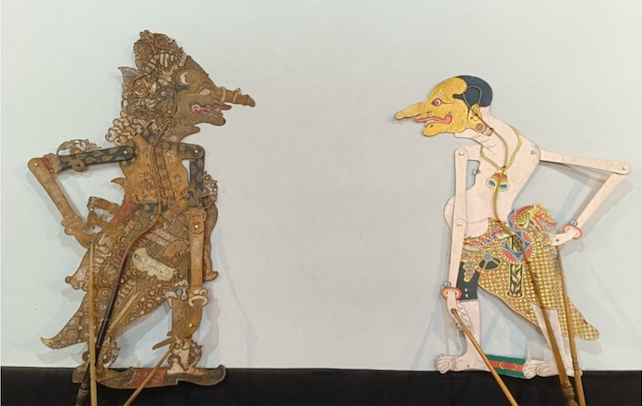
After visiting his Uncle Togog and officially joining the competition for Sari-hati’s hand in marriage, Petruk returns to his meditation. The vision of a Petruk figure from the past (the god Wisnu in disguise) emerges before him at the height of his meditation. Here Purbo Asmoro uses an actual antique Petruk figure that dates to the era of Pakubuwono X (r. 1893-1939), labelled in the live-streamed translation as Petruk 1920. Petruk 1920 confronts Petruk 2020, asking him what good such meditation could possibly do. He reminds the modern Petruk of the pandemic 100 years ago and how devastating it was. When the modern Petruk refuses to be discouraged, the god Wisnu, not quite ready to reveal himself, transforms from Petruk 1920 to a mysterious sage named Sarwa Langking, or All Black (the color black being associated with both Krĕsna and the god Wisnu). He grants Petruk the chakra amulet and tells him it will cure those infected with the virus. Petruk has passed the test of being chided and challenged, yet not dissuaded.
Meanwhile, our trio of characters in disguise are working together to block the entrance to Togog’s village so that no one can enter the competition for Sari-hati’s hand in marriage. This will, in turn, reduce the incentive for finding a cure for the virus. King Malaningrat (Rahwana), Ogre Darubĕksi (Sarpakĕnaka), and King Sarambaya (Bilung) battle both Petruk and the wayang hero Arjuna. They are eventually defeated and rendered back into their original forms. Petruk then tends to the ailing villagers in ‘Everyone-is-Sick,’ while sharing with them public health information on the treatment and spread of the disease, most of which is taken directly from the 1920 pamphlet. He does, however, add relevant instructions not provided in the earlier work – telling them, for instance, that they should mask up.
With Rahwana, Sarpakĕnaka, and Bilung defeated, and Petruk having healed all the land of the virus by using the chakra, the wedding between Petruk and Sari-hati begins. Suddenly chaos erupts. In comes King Krĕsna with Petruk’s jealous wife, Wrantawati, who is Krĕsna’s own daughter by one of his mistresses. King Krĕsna is clearly not concerned about the virus, or the forces of Rahwana and Sarpakĕnaka, only with his own private family matters. At this point, the sage Sarwa Langking transforms back to the god Wisnu and gives Krĕsna a piece of his mind. Krĕsna acknowledges his past and current transgressions and repents, after which Wisnu is willing to enter his being once more.
To conclude the performance, Purbo Asmoro reveals that Sari-hati is a divine vision and not actually mortal. She is an amulet of wellness that Togog has been entrusted with by Sang Hyang Wĕnang (The Almighty One). She incarnates into Wrantawati, both to make peace in the household and to symbolically entrust Petruk’s family with a divine power of wellbeing. Does Purbo mean for us to believe it is Petruk as a symbol of the commonfolk who has been entrusted with the amulet for wellbeing, or as a symbol of the dhalang? Herein lies the beauty and mystery of wayang, as it is up to each one of us to decide.
During the gara-gara interlude of this performance, Purbo Asmoro praises modern society for the vaccine and for the regulations that allowed Indonesians to avoid the level of devastation of the 1918 pandemic. He shows his audience photographs from the 1918 pandemic and suggests that Indonesians should feel optimistic that they have battled the virus well and are in a more positive position than those who suffered in 1918. At the same time, and although he is himself three-times vaccinated and willing to mask up when absolutely required, Purbo Asmoro has a general distaste for Western biomedicine. This is reflected in the world he creates in this lakon — a world without the Sir Doctor of the 1920 pamphlet, and without the chakra amulet full of Western medicines.
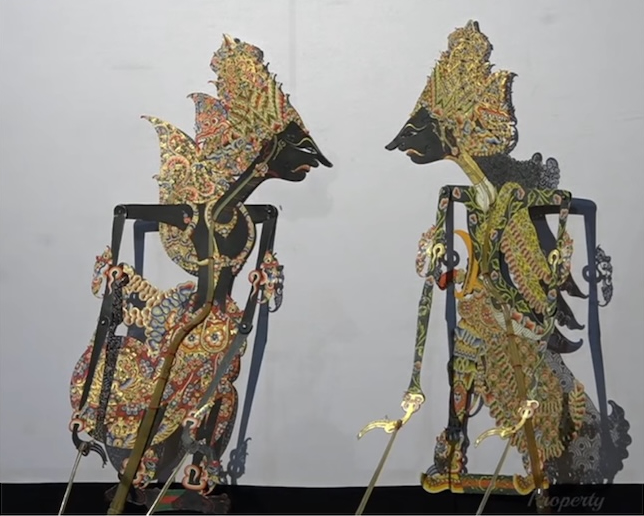
In this original work, Purbo Asmoro creates a more traditional, Javanese-mystical world – a world in which selfishness and a lack of integrity on the part of the powerful leads to the exit of any divine forces that may have been enlightening their decisions. This results in a decline in the character and self-confidence of society as a whole, leaving everyone vulnerable to the influence of evil, sometimes supernatural forces. These negative forces are symbolised here by the return of Rahwana and his sister Sarpakĕnaka. Purbo Asmoro’s other treatments of lakon during the COVID-19 era saw the return of the god Kala and his wife Durga, or Niwatakawaca and his descendants, or even hardline religious groups in Java.
In Purbo Asmoro’s Tamba Těka, Lara Lunga, the manifestation of this evil influence on society has been the virus and its variants complete with opportunists and their fake cures. Through meditation, self-reflection, self-sacrifice and a showing of empathy for others, the wisdom and influence of the god Wisnu can perhaps be brought back into society. And according to Purbo Asmoro, this will most likely start with commonfolk at the grassroots level, supported by their dhalang.
Kathryn ‘Kitsie’ Emerson (kemersonsolo@gmail.com) is the director of Ekalaya Performing Arts Center in Solo, Central Java, Indonesia and is the author of Innovation, Style and Spectacle in Wayang: Purbo Asmoro and the Evolution of an Indonesian Art (2022, NUS Press). All photos appear courtesy of Purbo Asmoro Official.



